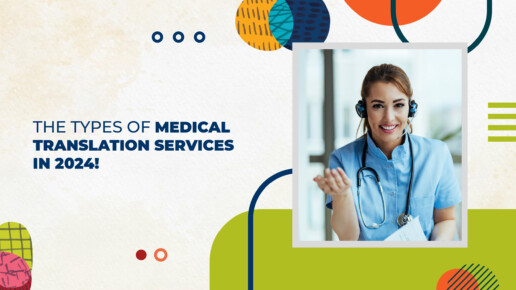The Types of Medical Translation Services in 2024!
The demand for accurate and reliable Medical Translation Services has never been higher. With the global reach of medical research, pharmaceutical developments, and patient care, ensuring clear and precise communication across languages is crucial. As we step into 2024, let’s explore the various types of medical translation services that are shaping the healthcare landscape.
What is Medical Translation?
Definition and Scope
Medical translation involves the translation of healthcare-related documents and materials from one language to another. This encompasses a wide range of content, including clinical trial protocols, patient information leaflets, medical device manuals, and more. The goal is to ensure that medical information is accurately conveyed to all stakeholders, regardless of their native language.
Key Differences from General Translation
Unlike general translation, medical translation requires specialized knowledge of medical terminology, regulatory standards, and cultural nuances. It’s not just about translating words but also about maintaining the integrity and accuracy of the information, which can have direct implications for patient health and safety.
Types of Medical Translation Services
Clinical Trial Translations
Clinical trials are critical for the development of new medical treatments and drugs. Translating clinical trial documents is essential for global research collaborations, patient recruitment, and regulatory submissions. These translations must be precise to ensure the validity of the trial data and compliance with international standards.
Regulatory Translation
Regulatory translation involves translating documents that are submitted to health authorities for approval. This includes applications for drug approval, compliance reports, and safety data sheets. Accurate regulatory translation is vital for ensuring that pharmaceutical products meet the legal requirements of different countries.
Patient Information Leaflet Translations
Patient information leaflets (PILs) provide essential information about medications, including usage instructions, side effects, and precautions. Translating PILs accurately is crucial for patient safety and understanding. These translations help ensure that patients from diverse linguistic backgrounds can safely use their medications.
Medical Device Documentation
Medical devices are used globally, and their documentation, including user manuals, safety instructions, and technical specifications, must be available in multiple languages. Accurate translation of these documents is essential for ensuring that healthcare professionals and patients can use these devices safely and effectively.
Pharmaceutical Translations
Pharmaceutical translations encompass a broad range of documents, including research papers, clinical study reports, marketing materials, and product labels. These translations support the global development and distribution of pharmaceutical products, ensuring that they meet local regulatory requirements and are understood by healthcare providers and patients.
Healthcare Interpreting Services
Healthcare interpreting involves real-time translation during medical consultations, hospital stays, and emergency situations. Interpreters facilitate communication between healthcare providers and patients who speak different languages, ensuring that patients receive accurate diagnoses and appropriate care.
Specialized Areas in Medical Translation
Oncology Translations
Oncology, the study of cancer, involves complex medical terminology and treatment protocols. Translating oncology documents requires specialized knowledge to ensure that research findings, treatment plans, and patient information are accurately conveyed.
Cardiology Translations
Cardiology translations focus on heart-related medical content. This includes research papers, clinical guidelines, and patient education materials. Accurate translation in this field is crucial for the effective treatment and management of heart diseases.
Radiology Translations
Radiology involves imaging techniques used to diagnose and treat diseases. Translating radiology reports, imaging protocols, and technical manuals requires expertise in medical imaging terminology and technology.
Genetic Research Translations
Genetic research is at the forefront of medical science, exploring the role of genes in health and disease. Translating genetic research papers, clinical study reports, and patient information requires a deep understanding of genetics and molecular biology.
Technological Advancements in Medical Translation Services
AI and Machine Learning
AI and machine learning are revolutionizing medical translation by providing tools that can assist with translation services accuracy and efficiency. These technologies can help identify context, suggest appropriate terminology, and even pre-translate content for human review.
Translation Memory Tools
Translation memory tools store previously translated content and use it to assist with new translations. This ensures consistency in terminology and phrasing, reduces translation time, and improves overall accuracy.
Terminology Management Systems
Terminology management systems help translators manage and standardize medical terminology. These systems ensure that the correct terms are used consistently across all translated documents, enhancing accuracy and compliance.
The Future of Medical Translation Services
Emerging Trends
The field of medical translation is constantly evolving. Emerging trends include the increasing use of AI, the integration of machine learning, and the growing demand for real-time translation services.
The Role of AI
AI is expected to play a significant role in the future of medical translation. AI-powered tools can assist with translation accuracy, speed up the translation process, and reduce costs, making high-quality medical translation more accessible.
Increasing Globalization
As globalization continues to expand, the need for accurate and reliable medical translation services will grow. This will drive innovation and improvements in translation technologies and methodologies.
Conclusion
Medical translation services is a vital service that ensures the accurate and effective communication of medical information across languages. As we move into 2024, the importance of quality medical translation cannot be overstated. By understanding the different types of medical translation services and the challenges involved, healthcare providers, researchers, and patients can benefit from improved global healthcare communication.

